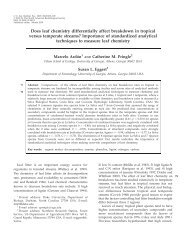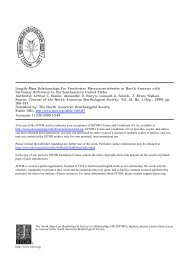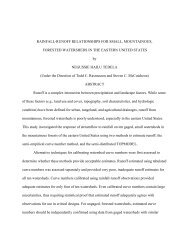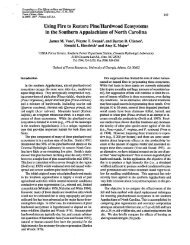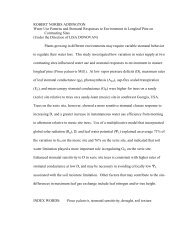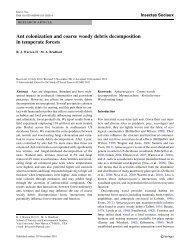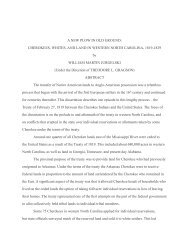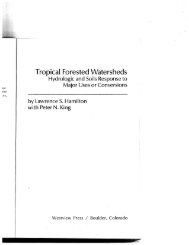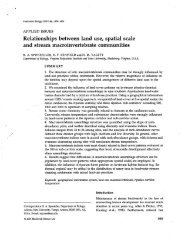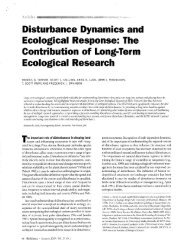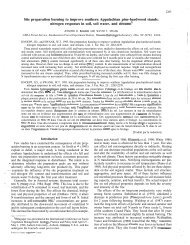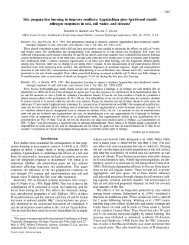biology join - Coweeta LTER - University of Georgia
biology join - Coweeta LTER - University of Georgia
biology join - Coweeta LTER - University of Georgia
You also want an ePaper? Increase the reach of your titles
YUMPU automatically turns print PDFs into web optimized ePapers that Google loves.
Articles<br />
(Min et al. 2011, Pall et al. 2011), which in turn have been<br />
linked to increased flooding and drought (Barnett et al.<br />
2008, Karl et al. 2009). Yet direct climate-trend effects on<br />
streamflow in headwater basins may be mitigated by ecological<br />
processes, including disturbance, succession, and<br />
vegetation adaptations to water scarcity. In many cases, the<br />
vegetation—and, therefore, evapotranspiration in headwater<br />
basins—is affected by human activities, such as past<br />
logging, grazing, agriculture, and fire suppression. Moreover,<br />
in some headwater basins, land-use changes, including agriculture<br />
and exurban expansion, may mitigate or overwhelm<br />
climate-trend effects on streamflow.<br />
Some observed trends in streamflow appear to be direct<br />
effects <strong>of</strong> climate trends. For example, increased streamflow<br />
in fall and spring at ARC, FRA, and NWT is probably the<br />
result <strong>of</strong> the expanding period <strong>of</strong> thaw at these tundra and<br />
boreal forest sites (figure 7f, 7g, 7i). Increases in streamflow<br />
at these sites may be driven by permafrost melt; changes<br />
in the chemical composition <strong>of</strong> streamflow support this<br />
hypothesis (Bowden et al. 2008, Caine 2010). In addition,<br />
increased spring streamflow at temperate forest sites with<br />
seasonal snowpacks in New England (HBR) and in the<br />
upper Midwest (MAR) is probably the result <strong>of</strong> earlier<br />
snowmelt, whereas increased winter streamflow at temperate<br />
forest sites in New England (HFR) may be the result <strong>of</strong><br />
a shift from snow to rain. These responses are consistent<br />
with the results <strong>of</strong> published studies (Hodgkins et al. 2003,<br />
Stewart et al. 2005, Clow 2010, Campbell et al. 2011).<br />
Some observed trends in streamflow may be the result<br />
<strong>of</strong> biological responses to climate change. For example,<br />
declining streamflow at a woodland site (summer at GCE), a<br />
boreal forest site (LVW), temperate forest sites (MAR, NTL),<br />
and wet temperate forest sites (spring at AND, OLY) may<br />
be the result <strong>of</strong> increased evapotranspiration in response to<br />
warmer temperatures. Conifer forests, which occur at MAR,<br />
NTL, LVW, AND, and OLY, are adapted to photosynthesize<br />
and respire when conditions are favorable; warmer temperatures<br />
may lead to an earlier onset <strong>of</strong> transpiration and<br />
to declining streamflow (e.g., Moore KM 2010). Streamflow<br />
trends at wet temperate and boreal forest sites (LVW, AND,<br />
OLY; figure 7) are restricted to the immediate period <strong>of</strong><br />
snowmelt, and declines may reflect increased evapotranspiration<br />
(Moore KM 2010, Oishi et al. 2010, Campbell et al.<br />
2011). In contrast, streamflow trends are largest during the<br />
nonsnowmelt periods at temperate forest sites in the upper<br />
Midwest (NTL, MAR), where wetlands (bogs and lakes)<br />
occupy a large proportion <strong>of</strong> basin area (Verry et al. 2011).<br />
Increased evapotranspiration associated with declining ice<br />
cover (Magnuson et al. 2000) or increased radiation associated<br />
with decreased precipitation may account for declining<br />
flows at these sites.<br />
Some sites experienced no trends in streamflow, despite<br />
increases in temperature. For example, desert sites (CAP and<br />
SEV) and the wet tropical site (LUQ) experienced significant<br />
increases in minimum and maximum daily temperatures,<br />
no change in precipitation (figure 6), and almost no changes<br />
in streamflow (figure 7a, 7b, 7s). Vegetation adaptations to<br />
drought might explain the lack <strong>of</strong> a streamflow response to<br />
warming at the desert sites. At the wet tropical forest site,<br />
the effects <strong>of</strong> the 1996 Hurricane Hugo on leaf area, evapotranspiration,<br />
and streamflow (Scatena et al. 1996) may have<br />
overwhelmed climate-trend effects.<br />
Some sites experienced trends in streamflow that appear<br />
to be biological responses to past disturbances. For example,<br />
forest succession and declining evapotranspiration may<br />
explain increased summer streamflow at two temperate<br />
forest sites (FER, HBR), which were logged in the early<br />
nineteenth century (figure 7k, 7m). At a third temperate<br />
forest site (CWT), streamflow and run<strong>of</strong>f ratios have not<br />
changed, despite increases in air temperature (figure 6,<br />
figure 7j). Forest succession following disturbances in the<br />
early 1900s at all three sites (table S1; Swank et al. 2001,<br />
Adams et al. 2006) and associated changes in species composition<br />
or leaf area may have influenced streamflow trends.<br />
Analyses <strong>of</strong> long-term paired-basin experiment data (e.g.,<br />
Jones and Post 2004) indicate that streamflow continues to<br />
change over decades or centuries <strong>of</strong> forest succession after<br />
disturbance.<br />
Responses to land use and disturbance, such as advanced<br />
snowmelt or declining summer streamflow, may be misconstrued<br />
as responses to climate change. In paired-basin<br />
experiments (see the discussion <strong>of</strong> long-term experiments<br />
in Knapp and colleagues 2012 [in this issue]), forest harvest<br />
advanced the timing <strong>of</strong> peak snowmelt and associated<br />
streamflow by up to three weeks in temperate forest sites<br />
with a seasonal snowpack (AND, HBR); the effect lasted for<br />
more than 10 years (Jones and Post 2004). By 25 to 35 years<br />
after forest harvest in temperate forest basins (AND, CWT,<br />
HBR), summer streamflow declined by up to 30%–50%<br />
relative to the reference basins (Hornbeck et al. 1997, Swank<br />
et al. 2001, Jones and Post 2004). Regenerating species in<br />
early forest succession may transpire more water per unit <strong>of</strong><br />
leaf area and, in some cases, have greater total leaf area than<br />
the species that were removed, which would reduce summer<br />
streamflow (Swank et al. 2001, Moore GM et al. 2004).<br />
Historic legacies from past disturbance in these long-term<br />
studies demonstrate that streamflow and timing responses<br />
to forest disturbance are at least as large as responses associated<br />
with climate trends over the past 20–60 years at the<br />
study sites. Daily streamflow during the late summer and<br />
early fall increased by up to 300% in the 1–5-year period<br />
after experimental forest harvest (AND, CWT, HBR), but<br />
most daily changes were on the order <strong>of</strong> 50% or less (Jones<br />
and Post 2004). By comparison, trends in daily streamflow<br />
associated with climate trends at the 19 study sites were on<br />
the order <strong>of</strong> 0.005–0.05 <strong>of</strong> log(Q) per year. The lower value<br />
is equivalent to changes <strong>of</strong> 10%–25%, and the higher value<br />
is equivalent to more than a 100% change over 20–60 years,<br />
but changes <strong>of</strong> this magnitude are restricted to a few days<br />
per year (figure 7).<br />
Finally, some observed trends in streamflow may be<br />
direct human effects on the hydrologic cycle. For example,<br />
400 BioScience • April 2012 / Vol. 62 No. 4 www.biosciencemag.org



